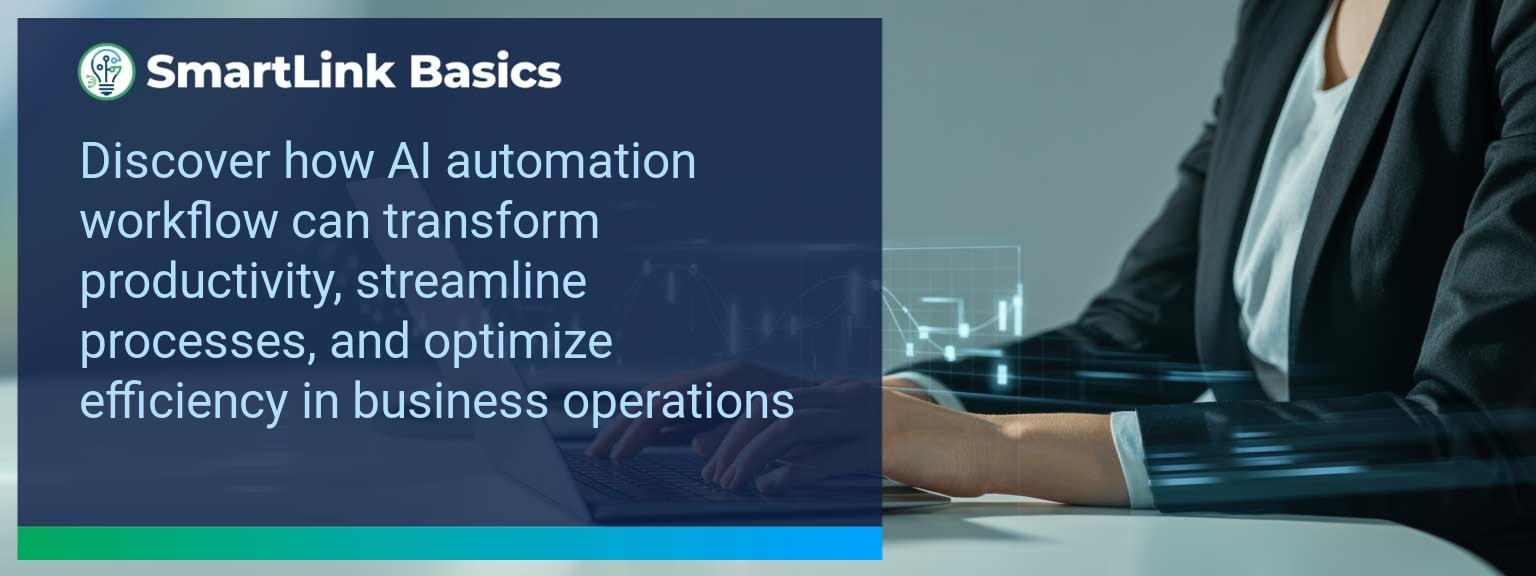McKinsey research shows that companies deploying AI in operations can improve productivity by up to 40%. For sales leaders, that translates into faster response times, stronger forecasting accuracy, and scalable deal execution. At SmartLink Basics, we see AI Automation Workflow adoption accelerating because it eliminates repetitive tasks, streamlines information flow, and sharpens decision-making. This shift matters now as competition speeds up and buyers expect instant, relevant engagement.
In this article, you’ll learn how to identify barriers, integrate automation tools, and measure impact. You’ll also see examples of AI workflow integration across revenue systems and emerging trends that will redefine daily operations for high-performing sales organizations.
- Define clear objectives before implementing AI automation workflow.
- Integrate automation tools that align with your CRM and sales tech stack.
- Focus on revenue-impacting processes first for maximum ROI.
- Measure leading, lagging, and quality metrics to track outcomes.
- Prepare for future trends in machine learning automation and intelligent workflows.
AI Automation Workflow: What Changed And Why It Matters Now
AI automation has evolved from isolated task automation to integrated intelligent workflows across entire revenue operations. Today’s systems unify CRM data, sales engagement platforms, and predictive analytics in real time. This alignment allows sales teams to reduce manual data entry, accelerate lead qualification, and automate follow-up sequences. A mid-market SaaS company we worked with integrated AI workflow integration into their deal management, cutting proposal turnaround from five days to one. Actionable insight: Focus on end-to-end process mapping before selecting tools so automation aligns with sales cycle stages.AI Automation Workflow: Redesign the Revenue Operating System
An effective AI automation strategy should begin with redesigning the revenue operating framework so processes can scale without bottlenecks. ICP, Segmentation, and Targeting AI can refine your Ideal Customer Profile by analyzing win-loss data and engagement signals. Automation tools then segment and target high-probability accounts automatically. Pipeline Architecture Dynamic pipeline scoring using machine learning automation ranks opportunities and suggests next actions, optimizing rep effort allocation. Plays and Messaging Generate and deploy context-specific plays—emails, calls, and social touchpoints—triggered by buyer behavior through platform integration. Operating Cadence Standardize weekly pipeline reviews and QBRs with AI-driven summaries, ensuring all stakeholders access consistent, updated intelligence. Actionable insight: Simplify operational layers first, then let AI enhance and accelerate them.Common Barriers To Process Optimization
Even strong teams struggle when technology adoption outpaces process readiness. Without defined workflows, automation tools risk amplifying inefficiency. Gaps often appear in data governance, tech stack alignment, and change management. One enterprise sales division introduced AI-powered task routing without addressing CRM hygiene, leading to poor lead assignment accuracy. Actionable insight: Audit data quality and user adoption milestones before expanding automation investment.Integrating Intelligent Automation For Better Results
Effective AI workflow integration depends on connecting automation tools directly to core business systems. The goal is seamless process optimization with AI, not layered complexity. Tools like intelligent document processing, sentiment analysis, and AI-driven forecasting create tangible productivity gains when embedded into daily sales motions. Example: A B2B manufacturer automated proposal generation using AI templates linked to inventory systems, cutting cycle time by 45%. Actionable insight: Automate processes where speed creates competitive advantage, starting with customer-facing touchpoints.Proven Impact On Efficiency And Output
Organizations applying AI productivity tools report shorter sales cycles, improved quota attainment, and tighter forecasting. Measured through both leading and lagging indicators, these gains reflect stronger customer engagement and internal alignment. Startups to global enterprises are using business automation to double the number of qualified meetings without increasing headcount. Actionable insight: Build a metrics dashboard that tracks speed-to-lead, conversion rates, and cycle length in parallel.| Category | Metric | Definition | Target |
|---|---|---|---|
| Leading | Speed-to-Lead | Time from lead arrival to first contact | Under 5 minutes |
| Lagging | Win Rate | Closed-won deals as a % of qualified opportunities | 35%+ |
| Quality | Data Hygiene Score | Completeness and accuracy of CRM data | 95%+ |
Emerging Trends In Intelligent Workflows
Machine learning automation is moving toward adaptive workflows that adjust in real time based on context and outcomes. Future AI productivity tools will not just execute tasks but recommend strategic pivots mid-cycle. In sales, this will include dynamic pricing adjustments, predictive deal desk approvals, and auto-generated multi-channel engagement streams. Firms tracking these developments position themselves ahead of competitors by testing innovations early, using AI-driven sales enablement resources from SmartLink Basics. Actionable insight: Allocate 10% of budget to experimentation with emerging automation technologies each year. <Get the 90-day plan, coaching rubric, and dashboard template to operationalize AI in your enablement program.









